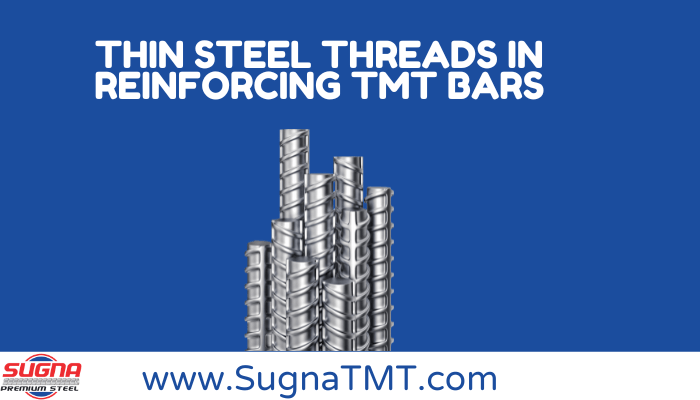In the construction industry, every detail plays a critical role in ensuring the strength, stability, and longevity of a structure. TMT (Thermo-Mechanically Treated) bars are the backbone of reinforced concrete structures, providing the necessary tensile strength to withstand various loads and stresses. While TMT bars themselves are robust and reliable, their performance can be further enhanced through the use of thin steel threads, commonly referred to as binding wires or reinforcing wires. These thin steel threads are essential in the process of securing and reinforcing TMT bars, ensuring that the entire structural framework remains intact and performs as intended. In this blog post, we will explore the role of thin steel threads in reinforcing TMT bars and their significance in modern construction.
What Are Thin Steel Threads?
Thin steel threads, often known as binding wires, are flexible, high-tensile steel wires used to tie or bind TMT bars at various junctions and intersections. These wires are usually made from mild steel and are available in different diameters or gauges, depending on the specific requirements of the construction project. Despite their small size, thin steel threads play a crucial role in maintaining the structural integrity of reinforced concrete frameworks.
The Role of Thin Steel Threads in Reinforcing TMT Bars

- Securing TMT Bars in PlaceOne of the primary functions of thin steel threads is to securely bind TMT bars together at the points where they intersect or overlap. This ensures that the TMT bars remain in the correct position during the entire construction process, including the pouring and setting of concrete. Without these binding wires, TMT bars could shift or move, leading to misalignment and potential weaknesses in the structure.
- Maintaining Structural IntegrityThe use of thin steel threads helps maintain the structural integrity of the reinforced concrete framework. By securely tying the TMT bars, these threads prevent any movement or displacement, which could compromise the load-bearing capacity of the structure. This is particularly important in large and complex structures, where even minor shifts in the reinforcement could lead to significant structural issues.
- Facilitating Uniform Load DistributionProper binding of TMT bars using thin steel threads ensures that the load is evenly distributed across the entire structure. When TMT bars are securely tied together, they work in unison to resist tensile forces, reducing the risk of localized stress concentrations that could lead to cracks or failures. This uniform load distribution is essential for the overall stability and durability of the building.
- Enhancing Flexibility in ConstructionThin steel threads offer a level of flexibility that is crucial during the construction process. They allow for adjustments to the position and alignment of TMT bars as needed, ensuring that the reinforcement meets the design specifications. This flexibility is particularly important in complex construction projects, where precise alignment of the reinforcement is necessary to achieve the desired structural performance.
- Preventing Corrosion and DamageWhile the primary function of thin steel threads is to secure TMT bars, they also play a role in protecting the reinforcement from corrosion and damage. By keeping the TMT bars firmly in place, binding wires help minimize movement that could cause abrasions or scratches on the bars, which could lead to corrosion over time. Additionally, the use of high-quality binding wires that resist corrosion further extends the lifespan of the reinforcement and, consequently, the entire structure.
- Simplifying the Construction ProcessThe use of thin steel threads simplifies the construction process by making it easier to handle and position TMT bars. These threads are easy to work with and can be quickly tied by hand or with the help of simple tools. This not only speeds up the construction process but also ensures that the reinforcement is installed accurately and efficiently, reducing the likelihood of errors or delays.
Types of Thin Steel Threads
Thin steel threads come in various types, each suited to different construction needs:
- Galvanized Binding Wires: Coated with zinc to prevent rust, these wires are ideal for use in environments where moisture and corrosive elements are present. They are commonly used in outdoor and coastal constructions.
- Stainless Steel Wires: Known for their superior corrosion resistance, stainless steel wires are used in structures that require long-term durability, especially in harsh environments.
- Annealed Binding Wires: These wires are heated and slowly cooled to increase their flexibility and ductility. They are used in situations where the binding needs to be adjusted frequently or where a high degree of flexibility is required.
The choice of thin steel threads depends on the specific requirements of the construction project, including environmental conditions, the type of TMT bars used, and the desired longevity of the structure.
Conclusion
Thin steel threads, though small in size, play an indispensable role in the reinforcement of TMT bars in construction. They ensure that the reinforcement remains securely in place, maintain structural integrity, facilitate uniform load distribution, and prevent corrosion and damage. By using the appropriate type of binding wire and ensuring proper installation techniques, construction professionals can significantly enhance the performance and longevity of their reinforced concrete structures.
In a field where every detail matters, thin steel threads are a critical component that contributes to the overall strength, safety, and durability of modern buildings. Their role in reinforcing TMT bars underscores the importance of precision and quality in construction, ensuring that the structures we build today will stand strong for generations to come.

